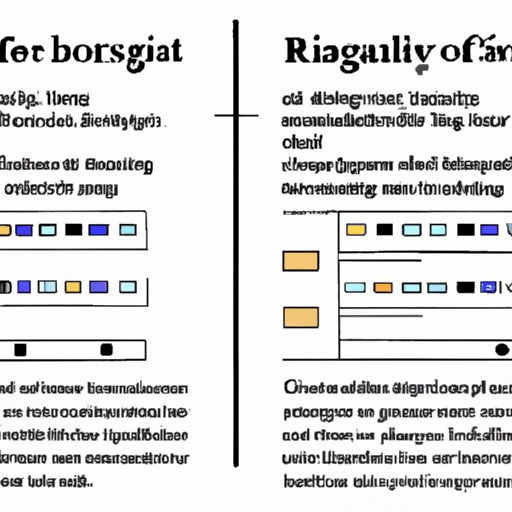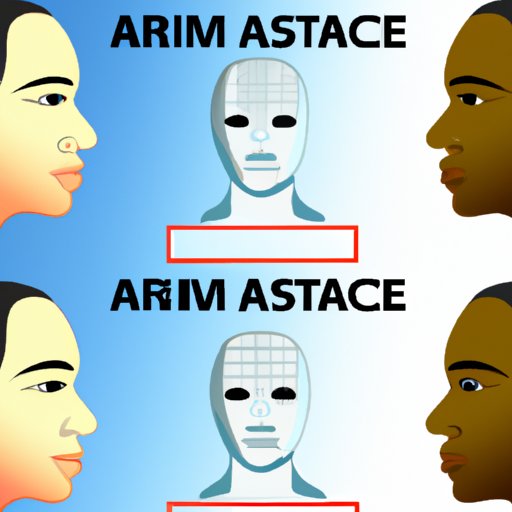Introduction
Artificial intelligence (AI) is a rapidly growing field that has seen widespread adoption across a variety of industries. As AI-driven technologies become increasingly prevalent, it is important to consider the implications of its use on social issues such as racism and racial inequality. This article will explore the role of AI in facilitating racial discrimination and examine potential solutions to reduce algorithmic bias.

Examining the Role of AI in Facilitating Racial Discrimination
AI algorithms are designed to automate decisions that were once made by humans. However, these algorithms are not free from bias and can perpetuate existing forms of discrimination. For example, a study conducted by the National Institute of Standards and Technology (NIST) found that facial recognition algorithms had higher false positive rates when identifying people with darker skin tones than those with lighter skin tones. This type of algorithmic bias can have serious implications on racial marginalization, particularly in fields such as criminal justice, where AI-driven decisions can have life-altering consequences.
Another example of AI-facilitated racial discrimination can be seen in online advertising. In 2019, researchers from the University of Virginia and Harvard Business School conducted an experiment in which they placed ads for jobs on Facebook targeting people of different races. The results showed that employers were more likely to target white job seekers over black ones, even when controlling for qualifications. This demonstrates how AI-driven decisions can lead to racial disparities in hiring practices.

Investigating Existing Algorithmic Bias and Its Impact on Racial Inequality
In order to address the issue of algorithmic bias, it is important to understand its root causes. One key factor is data quality. AI algorithms are only as good as the data they are trained on, and if the data contains biases or inaccuracies, the algorithms will reflect them. Furthermore, biased data can be further reinforced by AI algorithms, perpetuating existing stereotypes and inequities.
The impact of algorithmic bias on racial inequality can be seen in a variety of fields. For instance, a 2016 study by ProPublica found that software used to predict future criminals was twice as likely to falsely flag black defendants as likely to reoffend compared to white defendants. This type of algorithmic bias can have serious implications for racial minorities, who may be unfairly judged and sentenced because of a biased algorithm.
Analyzing How AI Can Be Used to Combat Racial Prejudice
Although AI algorithms can contribute to racial discrimination and inequality, they can also be used to mitigate it. One way to reduce algorithmic bias is to increase the diversity of the data sets used to train the algorithms. By providing AI algorithms with data sets that reflect the diversity of the population, the algorithms can better identify and account for individual differences.
Another solution is to use fairness-aware algorithms, which take into account factors such as race and gender when making predictions. These algorithms are designed to ensure that decisions are made in a fair and equitable manner, regardless of the characteristics of the individuals involved.
Finally, AI can also be used to detect and respond to instances of racism. For example, companies can use AI algorithms to monitor employee conversations for signs of racial prejudice and take appropriate action when necessary.

Discussing the Need for More Responsible AI Practices to Address Racism
In order to effectively address racism through AI, it is important to develop and implement best practices for responsible AI use. This includes establishing standards for ethical AI design, such as transparency, accountability, privacy, and security. Additionally, companies should conduct regular audits to ensure that their AI algorithms are compliant with these standards.
It is also important to create a culture of responsibility within organizations. Companies should provide employees with education and training on the ethical use of AI, as well as establish clear guidelines and policies for how AI algorithms should be used. This will help ensure that AI is used responsibly and ethically.
Conclusion
AI algorithms can be used to facilitate racial discrimination, leading to disparities in hiring practices, criminal justice outcomes, and other areas. To address this issue, it is important to reduce algorithmic bias by increasing the diversity of the data sets used to train AI algorithms and implementing fairness-aware algorithms. It is also essential to develop and implement best practices for responsible AI use, including establishing standards for ethical AI design and creating a culture of responsibility within organizations.
In conclusion, AI can be both a powerful tool for addressing racism and a source of racial discrimination. By taking steps to reduce algorithmic bias and promote responsible AI practices, we can work towards a future in which AI is used ethically and equitably.
(Note: Is this article not meeting your expectations? Do you have knowledge or insights to share? Unlock new opportunities and expand your reach by joining our authors team. Click Registration to join us and share your expertise with our readers.)
